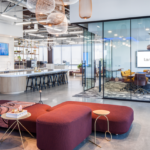By Jason Hughes
A flip of the calendar marked what seemed so surreal–the two-year anniversary of the pandemic–and this new way of life, and more importantly, a new way of work. As we all settle into the ‘new normal’ of our lives socializing, living with COVID-19, and of course, our work life, one thing remains still a bit uncertain, and in the flows of an ever-changing direction–the return to work in the office environment.
While many business leaders want teammates back in the office full-time, five days a week, utilizing the office space they pay rent on, others are taking an approach to a more adaptable, modern way of utilizing office space, while taking care of teammates and revamping what it means to ‘work from the office.’ I’ve been in the commercial real estate industry for more than 33 years, have seen a lot, and can tell you this–from economic downturns to natural disasters, to advanced technology, to more convenient ways of life–one thing remains true and will hold to the test of time–ninety-eight times out of one-hundred, employees will thrive and be more successful when working from the office, than from a completely remote, work from home model. That being said, life changes, and the office should reflect those changes as well. I offer the following insights for leaders to consider as they too navigate their return to office, and what the future holds:
1. Every geographic market and submarket are unique and have specific nuances based on the industry sectors and available office space.
This should be considered when developing an office plan to accommodate your business needs while taking care of your teammates. In San Diego, for example, some markets are experiencing opposite ends of the spectrum in rental and occupancy rates. Many suburban markets are doing well, however, the opposite is true for downtown San Diego, where there is record space availability with nearly zero activity. Similar stories can be found in most cities throughout the nation. Returning to “the office” in a downtown, still largely a ghost-town, won’t provide the same energy (and thereby attractiveness) as a well-occupied suburban campus with amenities and services available to all.
2. Every industry acclimates at its own pace and goes through different economic life cycles.
For example, the life science industry has been red hot for more than five years, but there is a slowdown coming. Biotech stocks are down across the board, which has a domino effect on raising capital. Meanwhile, every landlord that can convert or build space for the sector is under construction. Slowing demand and increasing supply never seems to work out well for landlords over the long-haul. This will push rents lower and vacancy higher, creating an opportunity for other potential uses.
3. Human beings are social creatures by nature.
A forced long-term quarantine due to a worldwide pandemic causing prolonged loneliness, boredom, anxiety and increased medical and health challenges is easier to adjust to when that is what the entire world is doing–and your life literally depends on it. Some people who are lucky enough to have multiple houses with separate offices, or a separate office space in their home, and a support system for childcare, chores and the routine errands of life, might not feel the same as those in a studio apartment where their home “office desk” is also their dining table or modified closet. It’s still way too early to understand the psychological effects of the pandemic, and it might be said that the same people who like working from home now will not like it for much longer, especially when others are at the office being stimulated and thriving with real human interaction, collaboration and building relationships.

4. Leaders and managers are all different and have varied styles of communication and performance management.
Some roles are truly better to be handled from the office. Some managers may need to engage in person at times with their team to be effective and to continue to maintain the collaborative nature of the work environment. While there are certainly roles that can be performed remotely, when necessary, as proven by the pandemic lockdowns, such as customer service and many professional services, it doesn’t mean the long-term effectiveness will be sustainable. There are simply too many factors that influence performance to think that working away from the office evermore will be as effective as working from an office, even in a hybrid model.
5. The office has been a successful business tool for centuries.
The first office building was built in 1726 in England. The Old Admiralty (Ripley Building), was the first purpose-built office building–many of the Royal Navy’s smaller offices were consolidated into Somerset House, as the first purpose-built office block throughout the 1770s. That was nearly 300 years ago. The odds are that two years of WFHome won’t completely obscure 300 years of WFOffice, no matter how technologically-advanced our work style and adaptability becomes.
6. Big companies are continuing to invest in office space regardless of the pandemic.
The big tech companies have added tens of millions of square feet to their office footprint over the last two years–during a global pandemic. What do they all know that others don’t? Why would they be in such rapid growth of OFFICE SPACE, and research and development space, if they thought no one would return to it? They likely have retained the most intelligent minds on the planet paying millions of dollars for studies and forecasts to advise on the best solution of a work environment–so I don’t think we should take this lightly. There is something to be said for the social and collaborative nature of working from the office, even in a hybrid situation, for two or three days per week.
In our company, I often remind our team to avoid confirmation bias as to their take on the future. That is, what we believe tends to be reinforced as truth because of one’s experience. Unfortunately, one’s experience may be a very small, and scientifically unsupportable, dataset, thereby perpetuating biased thinking. If we continually communicate that “everyone is downsizing,” others might think they should too. If we communicate that “employees will never return to the office,” others may think their employees won’t either. Your world then becomes a self-fulfilling prophecy. Meanwhile, at this stage in the post-pandemic work world, I believe it’s too early to know for sure what the future holds, and given so many factors (see items 1-6 above for starters), I think it is important to dig in and figure out what’s right for each individual organization and team.
Consider this. As the pandemic continued, what became apparently clear to great leaders is that culture will dictate your company’s morale and productivity. Maintaining or implementing a permanent hybrid work model, seems to be the best of both worlds for the time being, according to Lazlo Bock, former chief of Google human resources and current CEO of Humu, who explained in a recent Bloomberg article, “employee productivity and worker happiness, is a 3+2 schedule, in which three days are spent in the office, and two are remote.” This combination, he says, “gives individuals the chance to build relationships in-office and work on individual tasks that are easier at home.”

While many employees and companies adapted to full-remote work from home, work productivity didn’t falter, but what became clear, and reported in some studies, is the “workforce productivity per hour worked has dropped. People are working longer hours, taking fewer breaks, and working on weekends because it’s become impossible to turn off work,” Bock said.
The interesting thing is, we will know over the coming decade what a post-pandemic work situation looks like, but for now, as a leader of a company with more than 120 teammates to consider, I’m willing to make the best decision based on the current facts and feelings of my team, rather than take such a rigid position of a complete return to office based on something that is still too new. In the meantime, I recommend taking an in-depth approach to engaging with your teammates, by conducting surveys and communicating openly about wellness plans and guidelines for COVID-19 precautions, to maintain the culture you’ve worked hard to create, increase employee trust and morale, protect employee mental health, safeguard against employee resignations, and to better your company for long-term success.
Onward!
Jason Hughes is chairman, CEO, and owner of Hughes Marino, an award-winning commercial real estate company with offices across the nation. A pioneer in the field of tenant representation, Jason has exclusively represented tenants and buyers for more than 30 years. Contact Jason at 1-844-662-6635 or jason@hughesmarino.com to learn more.











